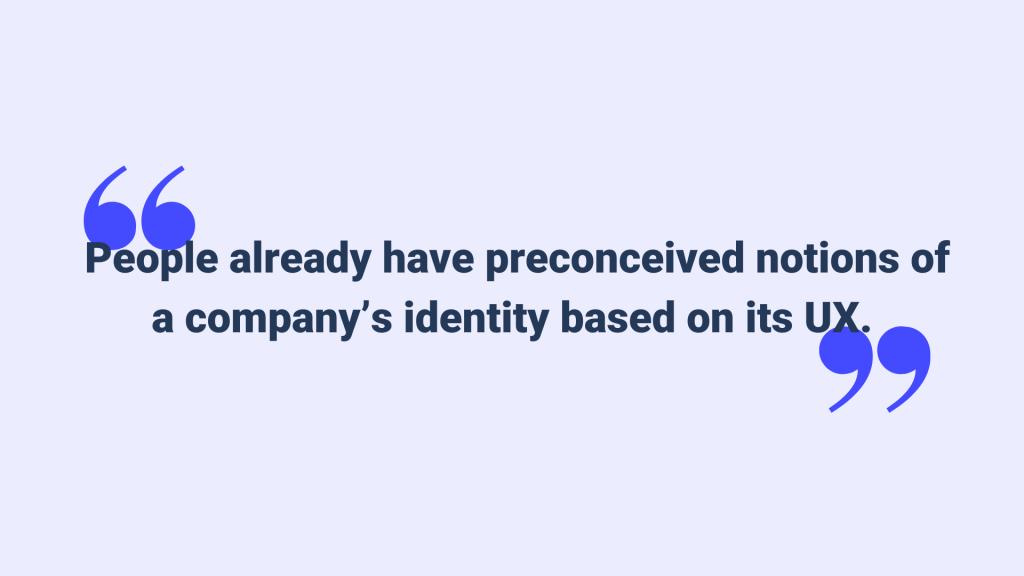Back to blog
4 MIN READ
How to Enhance UX Branding with Personalized Content
PUBLISHED
19 May, 2020


Everyone wishes to have a strong brand – one that keeps satisfied customers returning long after their first interaction; A brand that promotes experiences that not only meet, but exceed, the expectations of users.
However, not everyone realizes that such a brand is the result of tireless work and ingenuity.
Not everyone appreciates the importance of the UX design process – the process of crafting products, whether digital or physical, that are useful, easy to use, and a joy to interact with.
With most brands now commanding some level of a digital presence, customers are interacting with ubiquitous representations and brand behaviors 24/7.
Whether it is through the viewing of your website or engagement with an interactive virtual service you offer, your brand’s reputation is constantly being reinforced.
This means that, to a very large extent, your online brand experience is translating into your customer’s user experience.
User Experience Branding and Personalized Content
UX is much more than just digital touchpoints and user interfaces on a screen. It encompasses the user’s entire journey through your service, be it purely online or extending offline. These experiences impact what stories your users tell other people and the world at large about your brand.
And what’s more, even before having first-hand experience, people already have preconceived notions of a company’s identity based on its UX branding.


For example, people know Amazon for quick deliveries and almost instinctively “Google” everything under the sun.
Effective brand messaging spellbinds by increasing brand awareness, attracting new customers and becoming embedded in their minds.
UX branding is vital for your business as it leaves customers fulfilled through the effective delivery of core branded messages.
And if you had to pick the main actionable avenue for developing brand experience, personalization would be it.
However, while personalization has long been the darling of user experience practitioners and brands alike, doing it right is another issue altogether.
Don’t fall into the trap of believing that customization is enough. In this day and age, with users spending over 6 hours of their day online, there is much to organically discover about your users through the content that they consume or the ways they choose to consume.
In the same manner, giving them content that they want to see only strengthens your UX branding.
Marrying personalization and content
If you deal in information products or content, personalization is a straightforward proposition.
But even if you sell physical goods or services, it is a rare future-focused company that doesn’t deal with content in one way or the other. You might write about using your products in different industries; you might have to promote your services to people from different backgrounds.
With today’s necessities of doing business, all companies must contend with perfecting their content strategy. You may need to deal with press releases and news bites. If you’re building your brand, you may have to deal with cross-promoting on different platforms, managing social media campaigns, and interacting with your customers online.
Top tech companies have been developing strict brand styling guides and reaping the benefits of personalized content for while now. Here’s how you can follow suit and get started strengthening your brand experience.
Step 1: Define your brand’s objectives and purpose
You need to define your brand’s objectives and purpose, and ensure you are delivering a single cohesive message. An unfocused brand message will dilute the effectiveness of your efforts.
Nike’s Just Do It, or Apple’s minimalist and human-centered ethos, are both good examples of unmistakable brand messaging that permeates their UX branding. Readers know to go to National Review for coverage skewed to the conservatives, and The New Republic for the left.
They have distinct markets even though they serve their consumers the same thing: News. Strong and consistent brand messaging promotes brand loyalty and attracts more potential customers through the promise of the brand’s reputation.
Step 2: Categorize and Tag
Make sure that high-quality content is ready to be surfaced out to your audience. Ensure that content is always brand-focused, to further your messaging and minimize noise–there is enough content out there that will compete with your own messaging.
Common categorizing methods such as adding interest tags are simple, but don’t be limited by these. You can look at demographics-related categories. Article lengths (in words or minutes) are becoming a popular choice in differentiating content today.
Step 3: Anticipate
There are multiple ways to anticipate your users.
You can track PPC or keywords that your consumers use to arrive at your site; if they were looking for track shoes, they may be more interested in content about running and track than news about tennis matches.
You can also target content based on their location – either from existing user data or geo-targeting.
Try revising your copy depending on their location – whether it’s delivering them news about your nearest branch’s offers, telling them about local events, or simply providing them content in their own language.
Customers that come from your various social media campaigns may even provide you with important information.
But even without a campaign, the subset of your consumers who are interacting with your brand through different platforms may be different. Studying these communities and crafting your content depending on their consumption patterns will yield better engagement and interest from those communities.
Even users exiting your website or app can tell a tale. Personalized welcome back messages, abandoned cart reminder emails, and exit popups based on intent are all valid ways of connecting to your users.
Step 4: Monitor and track engagement
This is not a one-time process. With the speed at which the internet is evolving, your company needs to be quick enough to not get left behind–or better yet, to catch the wave of trends that may be beneficial to your company.
Taking a look at your users’ activities, creating customer journey maps, and analyzing different engagement metrics can all help your brand stay on top of the game.
Your UX branding is for the long game
Taking care of your UX branding is not a get-rich-quick scheme, it’s chess strategy. It is for brands that target the long-term, rewarding your company with strong returns due to its power to build loyalty and attract new customers.
Working on your personalized content strategy is an important piece of this puzzle, whether you are delivering information products or managing a retail business.
Don’t leave it to chance – take control of your UX branding.
Related Resource:
AUTHOR

Uwe Dreissigacker
What’s UXCam?
Related articles
App Analytics
Mobile App Tracking: Practical Guide & Best Tools [2026]
The best tracking tools for mobile...

Jonas Kurzweg
Product Analytics Expert
App Analytics
Top Analytics SDKs 2026
Pick the right analytics SDKs to improve your app's...

Jonas Kurzweg
Product Analytics Expert
Product best practices
8 Best UX Analytics Tools and Software We’ve Tested 2025
A good UX design is key when it comes to user satisfaction. Learn about five of the best UX analytics tools you can use to get valuable insights about user...

Jonas Kurzweg
Product Analytics Expert


